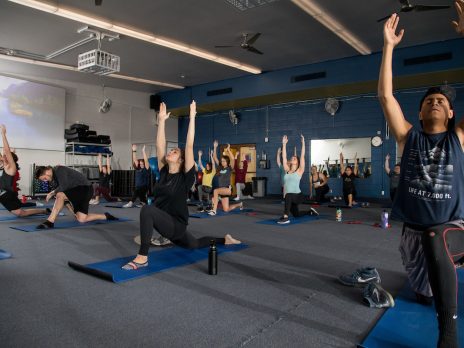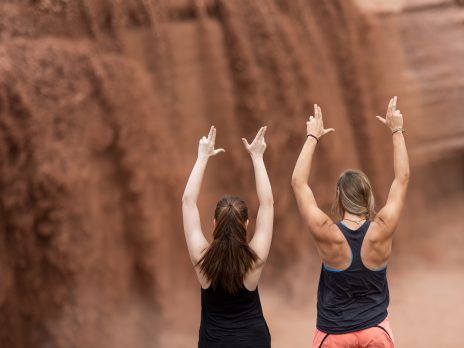Rediscover the Joy of Exercise, Part 2
If you missed our first blog on intuitive movement, check it out. And if you don’t have time, here’s the short version of the story – intuitive movement is all about tuning in and listening to your body. Your body will tell you when it wants to move, for how long, at what intensity, and in what ways. All you have to do is LISTEN to your body!
Intuitive movement isn’t about exercising to change your body shape or size, it’s about moving your body because if feels GOOD.
Good-bye #dietculture and hello #intuitivemovement!
Here are four more tips for moving towards intuitive movement:
 1. Be flexible (figuratively… and maybe even literally)
1. Be flexible (figuratively… and maybe even literally)
Many of us feel that we need structure and routine in order to maintain a fitness plan. While these components are hugely important, becoming too attached to a fixed exercise regime can become counterproductive.
Constantly adhering to such a regime involves depending on an external cue, which can undermine any effort to move intuitively. However, this doesn’t mean that we have to completely abandon our routine. It’s absolutely possible to strike a balance between structure and flexibility.
One way that you can do this is by creating what I like to call a ‘loose structure’. Once you’ve determined the kind of movement you enjoy, see if you can find a way to schedule that into your week, perhaps two to three times. This could translate into signing up for a couple of yoga classes or group fitness classes at a fixed time. At the same time, incorporate a few ‘free and flexible’ movement sessions into your week.
Set aside a few minutes to an hour on a couple of days where you give yourself permission to check in with your body and honor what it needs. On some days, this might take the form of an energizing run out in nature. On other days, it may involve a few gentle and restorative stretches in the comfort of your home.
Remember, movement is not limited to what we typically associate with the term ‘exercise’. Doing chores, walking to classes, and dancing freely to your favorite songs in your bedroom all count! So, on the days where you don’t have the time or energy to move as much as you’d like to, don’t be hard on yourself.
See if you can just dedicate a few minutes to any type of movement that fits your mood and honors where your body is at. If you’re exhausted and can’t do anything, that’s okay too! Such a big part of intuitive movement involves being able to relax and let go when our body is asking for rest. Being able to do this is a sign of strength and not weakness.
2. Move with intention
Check in with yourself frequently and get to know what your relationship with movement is currently like.
I cannot overemphasize the importance of intention! More often than not, our intention determines how we direct our attention. And our “energy flows where our attention goes”.
If your intention is to simply get a workout over and done with, then your attention is likely to be focused on how much time you have left, and what you’re going to do afterwards. This means that you’re probably not putting energy into being present and in the moment. You’ll therefore be missing out on a precious opportunity to connect with your body and to enhance that invaluable body-mind connection.
However, if your intention is to nourish your body through joyful movement, the whole energy of your workout changes radically. You’ll pay more attention to what feels good in your body, what feels challenging, and what kind of thoughts and sensations you experience throughout. At the end of the session, there will probably be a greater degree of harmony between your mind and body, and you’ll feel more grounded and connected to yourself for the rest of the day.
When it comes to intention, the best place to start is by simply reflecting on what typically motivates you to move, since this determines your intention. If you find that you’re usually motivated by external factors, try to set a more intrinsic intention the next time you exercise.
When I practice yoga, I like to set the intention of being kind to my body, as this completely transforms the energy of my practice. Instead of focusing on pushing myself as hard as I can, I find that I’m more inclined to respect my limitations on that particular day, while still ensuring that I move my body in a complete and satisfying way.
Other intrinsically oriented intentions could involve exercising to connect with your body (and get out of your head!), exercising to care for your body – in the same way you’d care for something or someone you love – and exercising to find a sense of freedom and catharsis in the midst of a stressful time.
3. Invite some mindfulness into your movement
How does moving in certain ways make your body feel? Check in with your body and mind both before, during and after a workout.
Mindful movement can be a real game changer. It can turn exercise into a moving meditation of sorts, where you’re exercising not only your body, but also your mind. Often, we tend to disconnect from our body whenever we experience any sense of physical discomfort. For example, holding a plank for a minute can feel like absolute torture.
Being mindful while planking can seem counterintuitive and maybe even a bit crazy. Who would want to concentrate on that burning sensation in the abs? Right about now, you may be tempted to dismiss this tip. But before you do, hear me out!
Multiple peer-reviewed studies document how mindful movement can significantly boost our overall sense of well-being by improving our cognitive and attentional skills, and reducing the extent of stress and anxiety we experience. Check out the links below to see for yourself!
What this means, essentially, is that moving mindfully amplifies the many benefits of exercise that most of us are familiar with. Mindful movement also trains us to redefine our relationship with discomfort, which can help us cope more effectively with some of the challenges that life inevitably throws our way. While it certainly takes time and practice to cultivate the skill of mindfulness, it is accessible to you at any given moment.
Ultimately, mindfulness does not require that we do or change anything. It simply invites us to become aware of what is already here. So, the next time you find your muscles aching in that dreaded plank pose, simply become curious about what’s going on.
You can start by noticing your breath. Are you holding your breath? If so, notice how that affects the tension in your body, as well as in your mind. Notice how the sensations change as you begin to breathe more deeply. As you delve into this quality of mindfulness, start to really explore the physical sensations that arise as you move your body. Naturally, some will feel energizing and enjoyable, while others will feel difficult and strenuous.
Allow yourself to hold space for all these sensations, without suppressing them, judging them or attempting to change them. Notice how transient they are. Just like the thoughts in our minds, they come and go. Sometimes, it may feel like a particular sensation lasts forever, but becoming mindful reminds us that nothing is permanent. See how this can become great training for so many other aspects of life?
In addition to becoming mindful of sensations within your body, you can try paying attention to your surroundings. When you’re walking or running out in nature, consciously soak up the colors, smells and sounds around you. When you’re taking a class, notice how everyone moves in a synchronized rhythm.
The more you practice this simple act of ‘noticing’, the more you become aware of how much there is to appreciate and take in. Exercise then becomes a lot more than physical movement – it becomes a practice of observation, concentration, acceptance and appreciation.
Links to some studies on mindful movement:
https://www.frontiersin.org/articles/10.3389/fnhum.2015.00297/full#h2
https://www.sciencedirect.com/science/article/abs/pii/S1469029217308178
4. Recruit a movement buddy
 While intuitive, mindful movement is certainly a personal and unique process, it does not necessarily have to be a solitary one. There are many benefits to exercising or moving with a friend or a group. In addition to keeping us accountable, movement buddies can infuse a powerful sense of collective intention into our activity. Imagine how inspiring and encouraging it can be when both you and your buddy are grounded in the shared intention to move in a kind and mindful way.
While intuitive, mindful movement is certainly a personal and unique process, it does not necessarily have to be a solitary one. There are many benefits to exercising or moving with a friend or a group. In addition to keeping us accountable, movement buddies can infuse a powerful sense of collective intention into our activity. Imagine how inspiring and encouraging it can be when both you and your buddy are grounded in the shared intention to move in a kind and mindful way.
Besides enjoying one another’s positive energy during the session, you can also spend some time sharing what you discovered and noticed after the session. Sharing this journey with a friend or family member can enhance your motivation, deepen the quality of your interpersonal relationships, and add a whole lot of fun to your movement.
Even when you’re alone, you can still find a sense of support by becoming your own movement buddy. This may sound strange and silly, but by becoming your own biggest cheerleader, you can start to create a new narrative when it comes to movement. Slowly but surely, you may notice the tone of your thoughts shifting from ‘pushy’ and judgmental to compassionate and accepting. Ultimately, this is one of the greatest gifts that intuitive, mindful movement rewards us with.
As we tune into our body, inquire about its needs and respect what it is trying to tell us, we start to relate to ourselves in a kinder and more loving manner. In this sense, finding movement you love is an act of self-love.